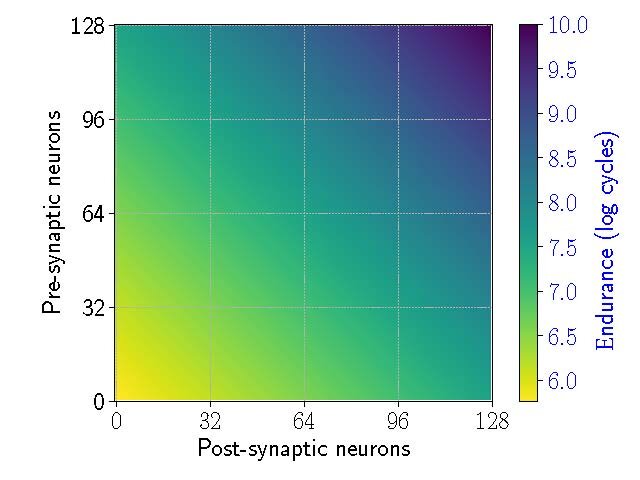In recent years, engineers worldwide have been trying to develop increasingly advanced and efficient neuromorphic computing systems, devices that mimic the neuro-biological structure of the central nervous system. Due to their bio-inspired architectures, these systems could be particularly desirable for executing machine learning (AI) algorithms and other artificial intelligence (AI) tools.
Unfortunately, the memory cells that implement synapse-like connections in these systems have a limited write endurance. This essentially means that they can be reliably programmed a limited number of times before they start exhibiting signs of ‘aging’ and deterioration. This can be problematic, as ‘aged’ memory cells often lead to functional errors in the programs executed by neuromorphic devices.
To overcome this challenge, researchers at Drexel University and University of California- Irvine created e-Spine, a technique that could increase the lifetime of neuromorphic systems. This technique, presented in a paper pre-published on arXiv, ensures that artificial synapses with higher activations are implemented on memristors with a higher endurance.
“Through circuit simulations at sub-micron technology nodes, we show that the memory cells in a neuromorphic system can have significant differences in write endurance,” Anup Das, one of the researchers who carried out the study, told TechXplore. “We call cells that have high endurance strong cells. Differences in endurance are caused by the variation in current propagating through different cells in a system.”
Essentially, if the cells that Das and his colleagues refer to as ‘weaker’ are heavily used (i.e., when the synapses mapped to these cells are activated too frequently), they will age faster. This can adversely impact a system’s overall usability, causing more errors.
The main objective of the study carried out by the researchers was to analyze the workload of a ML/AI algorithm and map its synapses to memory cells within the neuromorphic system executing it. Ultimately, they wanted to ensure that synapses exhibiting a higher activation are mapped to stronger cells.
To achieve their goal, Das and his colleagues developed a technique called eSpine, which automatically maps synaptic elements of artificial neural networks to the memory cells of a neuromorphic system. This can ultimately balance the endurance of memory cells in neuromorphic computing systems and increase their usable lifetime.
“The problem of finding a mapping solution for ML/AI workload on a neuromorphic system is a combinatorial optimization problem, which is NP-complete that is not solvable in polynomial time,” Das said. “We used Particle Swarm Optimization (PSO), a computational method that finds solution to an optimization problem by iteratively trying to improve a candidate solution with regard to a given measure of quality.”
In the context of the researchers’ study, the term ‘quality’ refers to a neuromorphic system’s lifetime, which is measured by recording the activation of its weakest cells. PSO techniques are inspired by swarm behavior in animals, such as birds’ flocking and schooling behaviors.
“For each solution that the PSO algorithm generates, eSpine maps the synapses to the memory cells by analyzing the synaptic activations within each workload,” Das explained. “Synapses with higher activations are mapped to stronger cells and vice versa. Eventually, when PSO finds the best solution, the average endurance of weaker cells is significantly improved.”
The technique devised by Das and his colleagues mitigates the endurance bottleneck of a neuromorphic system’s memory cells purely from a software mapping perspective. This process can be seen as equivalent to load balancing operations carried out by operating systems (OSs) in conventional computers.
In contrast with other techniques for improving the usable lifetime of neuromorphic systems, eSpine requires no action or involvement on behalf of developers. In addition, it does not affect or change the system’s hardware and interface.
The researchers evaluated the technique they developed in a series of experiments. Remarkably, they found that it led to usable lifetimes that were 3.5 times higher than those achieved using other state-of-the-art methods for extending a neuromorphic system’s lifetime.
“The key finding in our paper is that memory cell endurance varies significantly within a neuromorphic system and such variation is caused by variation of current propagating through the memory cells,” Das said. “The endurance variation becomes even more critical at elevated voltage and temperature.”
Typically, if a neuromorphic system is designed to operate for approximately 10 years, arbitrary synapse mapping techniques can lower its usable lifetime down to two years. By mapping synapses with higher activations to stronger memory cells, eSpine could increase the same system’s usable lifetime to seven years.
In the future, the technique devised by this team of researchers could thus prove highly valuable, as it could help to extend the lifetimes and enhance the durability of various neuromorphic devices. In their next studies, Das and his colleagues hope to develop eSpine further to address other limitations of neuromorphic systems.
“Stronger memory cells are also slower to access, meaning that activating these cells frequently would lead to slower performance,” Das said. “In the future, we plan to expand this research to also consider application slowdown.”
Neuromorphic computing with memristors
More information:
Endurance-aware mapping of spiking neural networks to neuromorphic hardware. arXiv:2103.05707 [cs.NE]. arxiv.org/abs/2103.05707
2021 Science X Network
Citation:
eSpine: A technique to increase the usable lifetime of neuromorphic systems (2021, April 13)
retrieved 17 April 2021
from https://techxplore.com/news/2021-04-espine-technique-usable-lifetime-neuromorphic.html
This document is subject to copyright. Apart from any fair dealing for the purpose of private study or research, no
part may be reproduced without the written permission. The content is provided for information purposes only.
